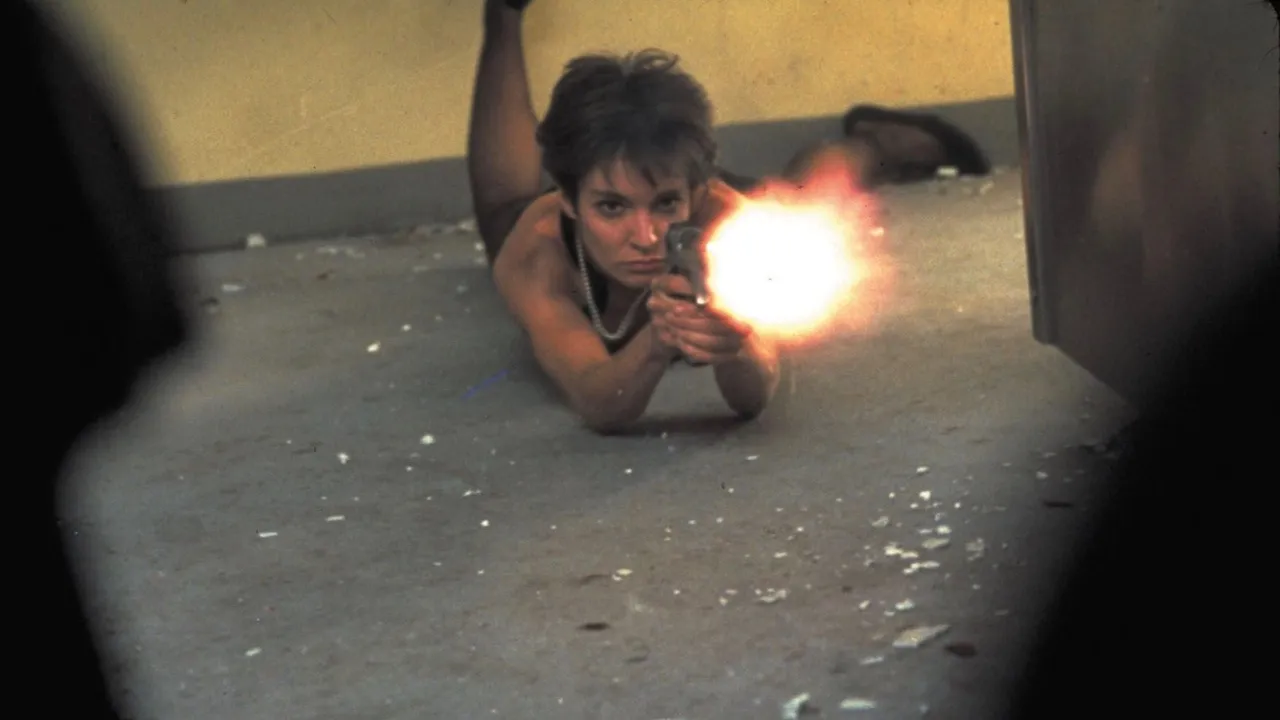
Luc Besson might not be the best, but is certainly the most successful French film maker in past decades. The secret of his success was in his ability to out-Hollywood the Hollywood by embracing action genre together with adoption of “style over substance” ethos that became prominent in commercial cinema of 1980s. The most successful film among those, at least judging by the number of remakes, is 1990 spy thriller La Femme Nikita.
The protagonist, played by Anne Parillaud, is Nikita, teen drug addict who at the beginning of the plot joins gang of street punks that try to rob a pharmacy. The robbery goes terribly wrong, leading to police intervention and armed confrontation that would end in bloodbath. During the mayhem Nikita shoots policeman to death and is later sentenced to life in prison. Before she starts serving her sentence, she gets drugged and brought to mysterious institution where mysterious man named Bob (played by Tcheky Karyo) informs her that she officially committed suicide and was buried. The only way for her to avoid her grave being filled for real is to take part in top secret government program during which she would be trained for covert operative. She reluctantly agrees and gradually becomes expert in computers, martial arts and weapons, while elderly woman named Armande (played by Jeanne Moreau) teaches her how to make herself beautiful and use feminine charms during her work. After few years Nikita is brought to outside world where he puts her deadly skills to good use during assassination and even shows ability to improvise under pressure. Bob and his bosses allow her to leave her training centre and begin something of a regular life under new identity and cover of nurse. One day, while shopping for groceries, she meets charming shopping clerk Marco (played by Jean-Hugues Anglade) and starts romantic relationship with him. Two of them live happy life which is interrupted when Nikita’s bosses activate her for new missions. Those missions become not only increasingly complicated and dangerous, but also take unexpected emotional toll on Nikita who wants nothing other than living with Marco in peace.
La Femme Nikita, like most of Besson’s early works, is an example of “Cinéma du look”, trend in French cinema that tried to fuse recognisable visual style of art cinema with action and other commercial genres. Besson, who wrote and directed the film, indeed does a splendid job in establishing specific style with each shot being meticulously staged. Each scene is given proper atmosphere with the help of cinematographer Thierry Arbogast and Besson’s old associate Eric Serra who delivers likeable synthesiser score. Besson directs action scenes with even more skill, starting with chaotic showdown in the pharmacy and ending with complicated and even more chaotic scene at the embassy. La Femme Nikita provides memorable experiences for all those who like films to be stylish. However, the actual content leaves something to be desired, although Besson’s script happens to be somewhat more substantial than in his previous films. La Femme Nikita actually has interesting concept – troubled individual from the bottom of society given chance for better life in exchange for working as ruthless assassin – and it actually builds on it, at least in the first half when we see gradual transformation of Nikita from rebellious, violent and unpredictable street urchin into suave, ellegant woman who works as efficient killing machine. In the second part, Besson is a little bit less successful in showing Nikita’s attempts to restore her humanity with relationship with kind Marco. The ending, which is unusually ambiguous for these sort of films, also leaves something to be desired.
On the other hand, Besson was very fortunate to cast Anne Parillaud, immensely talented actress who was his wife at the time, in the lead role. Parillaud delivers broad range of emotions – from rebellious rage to despair – with great skill and creates one of the most iconic characters of the genre known as Girls with Guns. This character is, despite Besson’s failure to build background for it apart from few hints, very believable and rounded. Jean-Hugues Anglade has good chemistry with her, but his performance is overshadowed by Tcheky Karyo as her enigmatic boss who displays fondness for Nikita but doesn’t hesitate to cynically manipulate her. Jean Reno makes very good impression in the role of sinister Victor “the Cleaner”, character that would inspire both the protagonist of Besson’s Leon the Professional and Winston Wolf in Tarantino’s Pulp Fiction. La Femme Nikita in the end proved one of the most influential films of Besson’s career. It left such good impression that it was remade in Hollywood by John Badham as Point of No Return and later twice on television – in 1990s series starring Peta Wilson and in 2010s series starring Maggie Q.
RATING: 7/10 (+++)
Blog in Croatian https://draxblog.com
Blog in English https://draxreview.wordpress.com/
Leofinance blog @drax.leo
Cent profile https://beta.cent.co/@drax
Minds profile https://www.minds.com/drax_rp_nc
Uptrennd profile https://www.uptrennd.com/user/MTYzNA
Unstoppable Domains: https://unstoppabledomains.com/?ref=3fc23fc42c1b417
Hiveonboard: https://hiveonboard.com?ref=drax
Bitcoin Lightning HIVE donations: https://v4v.app/v1/lnurlp/qrcode/drax
Rising Star game: https://www.risingstargame.com?referrer=drax
1Inch: https://1inch.exchange/#/r/0x83823d8CCB74F828148258BB4457642124b1328e
BTC donations: 1EWxiMiP6iiG9rger3NuUSd6HByaxQWafG
ETH donations: 0xB305F144323b99e6f8b1d66f5D7DE78B498C32A7


